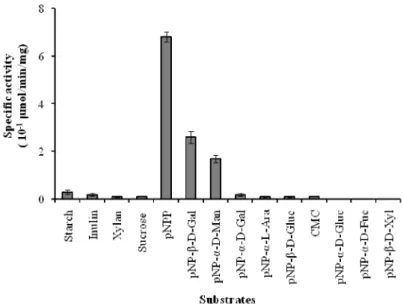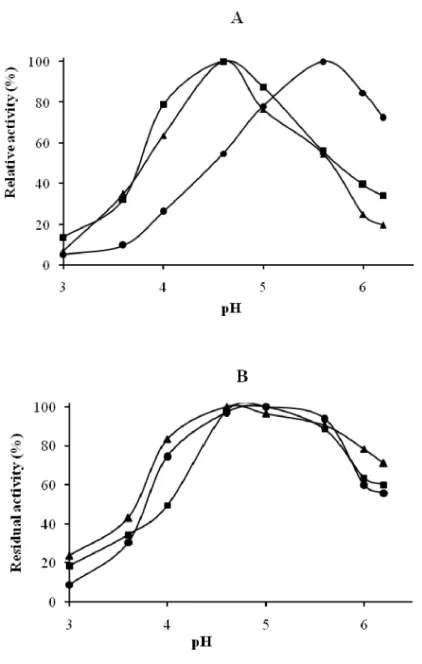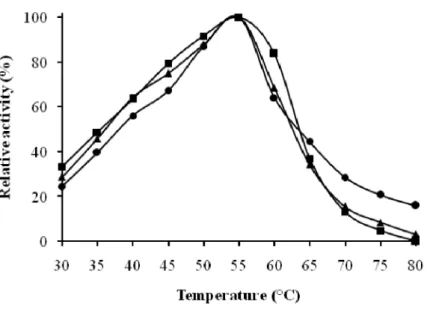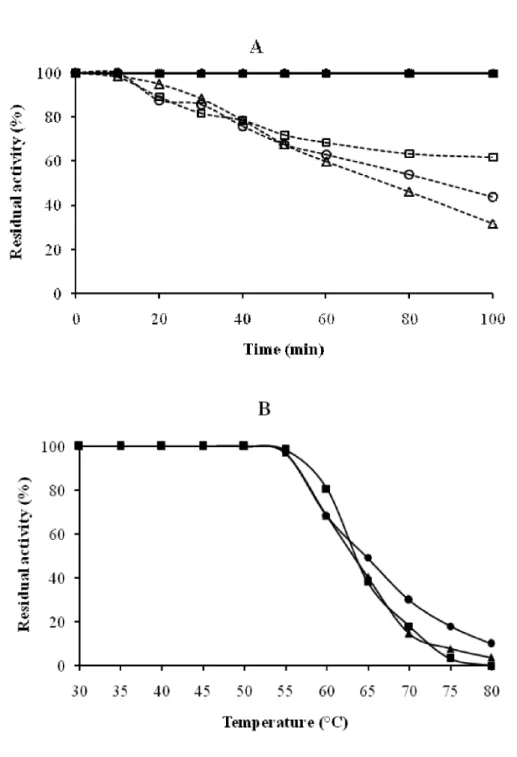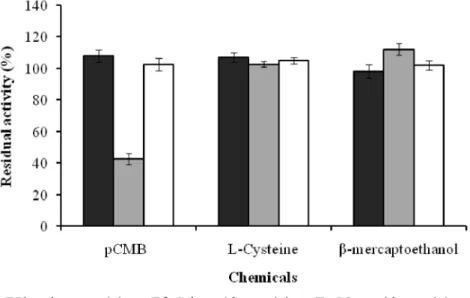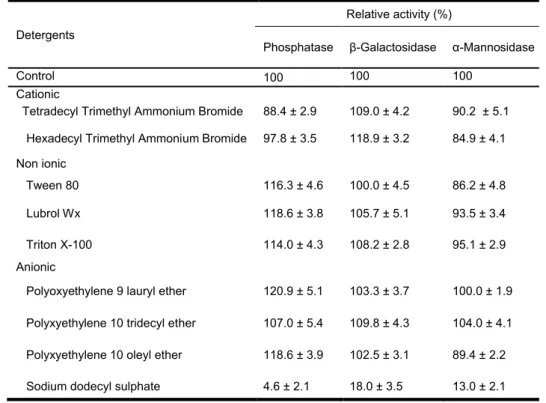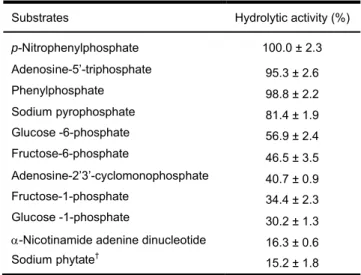Biochemical characterization of phosphatase,
-galactosidase and
-mannosidase activities of seeds of an oleaginous cucurbit: Lagenaria
siceraria (Molina) Standl blocky-fruited cultivar
Djary M. KOFFI1, Betty M. FAULET2, Jean T. GONNETY2, Micaël E. BÉDIKOU1, Lucien P. KOUAMÉ2, Irié A. ZORO BI3 & Sébastien L. NIAMKÉ1*
1 Laboratoire de Biotechnologies, Filière Biochimie-Microbiologie de l’Unité de Formation et de Recherche Biosciences de l’Université de Cocody, 22 BP 582 Abidjan 22, Côte d’Ivoire
2 Laboratoire de Biochimie et Technologie des Aliments de l’Unité de Formation et de Recherche des Sciences et Technologies des Aliments de l’Université d’Abobo-Adjamé, 02 BP 801 Abidjan 02, Côte d’Ivoire
3 Laboratoire de Génétique de l’Unité de Formation et de Recherche des Sciences de la Nature de l’Université d’Abobo-Adjamé, 02 BP 801 Abidjan 02, Côte d’Ivoire
*Auteur pour les Correspondances (Email: niamkes@yahoo.fr) Received 18-03-2010, accepted 21-06-2010.
Abstract
Seeds extract of Lagenaria siceraria (Molina) Standl (blocky-fruited cultivar) was screened for enzymatic hydrolytic activities over synthetic variety and natural substrates. The best hydrolytic activities mainly consisted of phosphatase (0.68 ± 0.02 UI/mg), -galactosidase (0.26 ± 0.03 UI/mg) and -mannosidase (0.17 ± 0.02 UI/mg). Physicochemical characterization showed that these enzymatic activities were maximal at 55°C in sodium acetate buffer (pHs 4.6 and 5.6). They showed pH and temperature stability and appeared to be resistant in the presence of 5 mM cations (Na+, K+, Ca2+, Ba2+ and Mg2+) concentration and 1% (w/v) detergents (cationic, non-ionic and anionic). The phosphatase activity on different phosphorylated substrates showed it ability to hydrolyze greatly para-nitrophenylphosphate (100 ± 2.3%) and ATP (95.3 ± 2.6%) and in lesser extent sodium phytate (15.2 ± 1.8%). As for natural substrates as lactose and the three different mannobioses linked (-1,2; -1,3 -1,6), that were significantly hydrolyzed by -galactosidase and
-mannosidase activity respectively. These interesting characteristics deserved to be deeply investigated for the valorisation of Lagenaria siceraria seeds phosphatase, -galactosidase and -mannosidase in potential biotechnological applications.Key words: Oleaginous cucurbit, Lagenaria siceraria, blocky-fruited cultivar, seeds, phosphatase activity,
-galactosidase activity, -mannosidase activity.
Résumé
Caractérisation biochimique des activités phosphatasique, -galactosidasique et -mannosidasique des graines d’une cucurbite oléagineuse : cultivar à baie allongée de Lagenaria siceraria (Molina) Standl Divers substrats naturels et synthétiques ont été testés lors du criblage d’activités enzymatiques à partir de l’extrait brut des graines du cultivar à baie allongée de Lagenaria siceraria (Molina) Standl. Les meilleures activités observées sont les activités phosphatasique (0,68 ± 0,02 UI/mg), -galactosidasique (0,26 ± 0,03 UI/mg) et -mannosidasique (0,17 ± 0,02 UI/mg). La caractérisation physico-chimique de ces activités enzymatiques a montré qu’elles sont maximales à 55°C dans le tampon acétate de sodium (pHs 4,6 et 5,6). Elles ont montré également une bonne stabilité en fonction du pH et de la température aussi bien qu’en presence de concentrations de 5 mM de solutions ioniques (Na+, K+, Ca2+, Ba2+ et Mg2+) et de 1% (p/v) de détergents (cationique, non-ionique et anionique). La spécificité de substrat
réalisée sur des composés phosphorylés a revelé une hydrolyse prépondérante du para-nitrophenylphosphate (100 ± 2,3%) et de l’ATP (95,3 ± 2,6%) tandis que le phytate de sodium est hydrolysé a un degré moindre (15,2 ± 1,8%). Le lactose et les différents mannobioses (-1,2; -1,3 -1,6) sont également bien hydrolysés respectivement par les activités -galactosidasique et -mannosidasique de l’extrait. Ces propriétés attrayantes mériteraient des études plus approfondies pour la valorisation de la phosphatase, de la -galactosidase et de l’-mannosidase des graines de Lagenaria siceraria en vue de leurs utilisations potentielles dans des procédés biotechnologiques.
Mots clés: Cucurbite oléagineuse, Lagenaria siceraria, cultivar à baie allongée, graines, activité phosphatasique, Article original
1. Introduction
Cucurbitaceae is a wide family of plants having great importance in tropical agriculture (Dupriez & De Leener, 1987; Pitrat et al., 1999). This family is mainly divided into two main groups based on their consumption mode: those with edible fleshes as watermelons, melons and marrows, and those with oleaginous seeds consumed as traditional soup thickeners called «pistachio» soup in Côte d’Ivoire and «egusi» soup in Cameroon, Nigeria and Benin (Zoro Bi et al., 2003; Djè et al., 2006). Seeds of oleaginous cucurbits have already been reported for richness in nutrients as minerals (sulphur, calcium, potassium, phosphorus, iron, magnesium and zinc), proteins (36%) and fats (50%) (Akobundu et al., 1982; Achu et al., 2005; 2006; Loukou et al., 2007). Furthermore the high-quality of «pistachio» oils, considering their content in unsaturated and essential fatty acid particularly in linoleic acid (Achu et al., 2006; 2008), made them recommended in cardiovascular illnesses. Due to their agronomic, nutritional and economic potentials, cucurbits are considered as materials for which improved production and use can result in food security and income generation for peasants (Zoro Bi et al., 2006; Esfeld et al., 2009). despite these potentialities, these crops are somehow neglected as minor crops (Achigan-Dako et al., 2006; Rasul et al., 2007).
Lagenaria siceraria (Molina) Standl belonging to this family of crop (Cucurbitaceae) is one of the most widely distributed and consumed at both rural and urban level in Sub-Saharan Africa (Zoro Bi et al., 2006). However, agronomic, botanic and nutritional studies have been investigated while significant scientific aspects in particular the enzymatic constituent remains still unexplored. Enzymes are essential biocatalysts to living organism beings. In this respect, any loss of enzymatic activity is irremediably followed by metabolic disorders (Noble & Bovey, 1997; Kranz
et al., 2007). Interest in enzymes also lies in their
usages for various biotechnological purposes (Oehmig et al., 2007; Betancor et al., 2008; Bédikou et al., 2009a). For specific examples, enzymatic hydrolysis of lactose by -galactosidases in production of low lactose milk (and dairy products made from it) is essential for lactose intolerant patients (Dwevedi & Kayastha, 2009). Depending to both their hydrolytic and transferasic activity, phosphatases were reported be used to modify macromolecules useful for food
processing industries as drinks, cream substitutes and mayonnaises (Larré & Schwenke, 1996). In pharmaceutical industry, -mannosidases are currently used for treatment of mannosidosis, a congenital disorder of glycosides (CDG), by enzyme replacement therapy (Hirsch et al., 2003). In view of these practical domains of enzymes application above, research for new enzyme sources with improved properties remains of topical interest. The aim of this work is to promote a minor crop as the blocky-fruited cultivar of Lagenaria siceraria by investigating its seeds enzymatic potential through biochemical characterization for further biotechnological applications.
2. Materials and Methods
2.1. Materials
2.1.1. Enzymatic source
Seeds of the blocky-fruited cultivar of Lagenaria
siceraria were collected from University of Abobo-Adjamé (Abidjan, Côte d’Ivoire). To obtain sufficient number of seeds, L. siceraria round-fruited cultivar was grown during rainy season (April to July) in 2009 at the experimental farm of the University (5°23N, 4°00W, and 7 m above sea level). After harvesting, fruits were split using a stainless steel kitchen knife and the seeds removed for crude extract preparation.
2.1.2. Chemicals
para-nitrophenyl- (pNP-) glycopyranoside
substrates [pNP--D-mannopyranoside (pNP- -D-Man), pNP--D-glucopyranoside (pNP- -D-Glu), pNP--D-glucopyranoside (pNP--D-Glu),
pNP--D-galactopyranoside (pNP--D-Gal), pNP--D-galactopyranoside (pNP--D-Gal),
pNP--L-fucopyranoside (pNP--L-Fuc),
pNP--L-arabinopyranoside (pNP--L-Ara), pNP- -D-xylopyranoside (pNP--D-Xyl)], para-nitrophenyl phosphate (pNPP), phenyl phosphate, sodium pyrophosphate, glucose-1-phosphate, glucose-6-phosphate, fructose-6-glucose-6-phosphate, fructose-1-phosphate, -nicotinamide adenosine dinucleotide (-NAD), adenosine-2-3’-cyclomono-phosphate, adenosine-5’-triphosphate (ATP), phytate, para-nitrophenol (pNP), sucrose, starch, carboxymethylcellulose (CMC), Inulin, xylan, lactose, 2-O- -D-mannopyranosyl-D-manno-pyranoside (-1,2 Mannobiose), 3-O-
-D-mannopyranosyl-D-mannopyranoside (-1,3 Mannobiose), 6-O- -D-mannopyranosyl-D-mannopyranoside (-1,6 Mannobiose), D-mannose and D-glucose were purchased from Sigma Aldrich. Bovine serum albumin (BSA) was from Fluka Biochemika.
2.2. Methods
2.2.1. Enzymes preparation
Cucurbit seeds (10 g) were ground using an electric blender (PALSON, Spain) in 20 ml sodium chloride solution 0.9% (w/v). The homogenate was sonicated using a TRANSSONIC (T420, Germany) for 10 min and, then centrifuged (Spinner HERMLE Z300K, Germany) at 10,000 g for 30 min at 4°C. The supernatant filtered through sterilized cotton was used as the crude extract (seeds extract).
2.2.2. Hydrolytic screening of synthetic and natural substrates
As for synthetic pNP-glycoside and pNP-phosphate hydrolytic activities, crude extract was mixed in 250 µl composed of aryl-substrate (5 mM) in 100 mM sodium acetate buffer pH 5.0 and crude extract (50 µl correspond to 0.21 mg of protein), incubated for 10 min with shaking at 37°C. The liberated para-nitrophenol (pNP) was quantified spectro-photometrically (SPECTRONIC GENESIS 5, USA) at 410 nm under alkaline conditions (2% w/v, Na2CO3) referred to a standard pNP (absorbance as a function of concentration) curve obtained in similar conditions.
For natural substrates hydrolysis, the total volume was 300 µl composed of crude extract (50 µl) and 125 µl of substrate (0.25% w/v, final concentration) in 100 mM sodium acetate buffer pH 5.0. The mixture was incubated for 30 min with shaking at 37°C, then stopped by adding 150 µl of dinitro salicylic acid (DNS) and at 100°C for 5 min (Bernfeld, 1955). Reducing sugars were quantified spectrophotometrically at 540 nm referred to standard glucose curve.
The experiment conditions described above constituted the standard «enzyme assay conditions». All values were determined in triplicate. One unit of enzymatic activities in the two cases (synthetic and natural substrates) release 1 µmol of liberated product (pNP or reducing sugar) per min. Specific activity was expressed as ìmol per min (UI) per mg of proteins.
2.2.3. Measurement of proteins concentration
The proteins concentration was measured by using Folin ciocalteu method (Lowry et al., 1951). BSA was used as the standard protein.
The following reagents were used: Reagent A: 2% Na2CO3 in 0.10 N NaOH. Reagent B: 0.5% CuS04.5H2O in 1% sodium and potassium tartrate. Reagent C: alkaline copper solution, Mix 50 ml of Reagent A with 1 ml of Reagent B. Discard after 1 day. Reagent D: carbonate-copper solution, is the same as Reagent C except for omission of NaOH. Reagent E, diluted Folin-Ciocalteu phenol reagent (about 2-fold) 1 N acid with 0.10 N NaOH. To a sample of 0.2 ml, in a 3 to 10 ml test-tube, 1 ml of Reagent C is added. Mix well and allow standing for 10 minutes at room temperature. Then 0.10 ml of Reagent E is added very rapidly and mixed within a second or two. After 30 minutes at obscurity, the sample is quantified spectrophotometrically.
2.2.4. pH optimum and pH stability determination
The effect of pH on the enzymatic activities was determined by performing the hydrolysis of para-nitrophenylphosphate, para-nitrophenyl- -D-galactopyranoside and para-nitrophenyl- -D-Mannopyranoside in a range of buffers (100 mM) at various pH values ranging from 3.0 to 6.2. Sodium acetate buffer from pH 3.6 to 5.5 and sodium citrate buffer from pH 3.0 to 6.2 were used. The pH values of each buffer were determined at 25°C.
The pH stability of each enzymatic activity was studied in a pH range of 3.0 to 6.2 with 100 mM sodium citrate buffer. After 2 hours preincubation at 25°C, residual activities were measured at 37°C for 10 min by adding the substrate (pNPP, pNP- -D-Gal or pNP--D-Man).
2.2.5. Temperature optimum and temperature stability determination
The effect of temperature on phosphatase, -galactosidase and -mannosidase activities was performed in 100 mM acetate buffer (appropriate pHs) in a temperature range of 30 to 80°C by using pNPP, pNP--D-Gal or pNP--D-Man (5 mM) as substrates under the enzyme assay conditions.
The thermal inactivation was determined at 37°C and at each enzymatic activity optimum temperature. Enzymes in appropriate buffers (pHs) were exposed to each temperature for 0 to 100 min. Aliquots were withdrawn at intervals and cooled immediately. Concerning thermal denaturation tests, aliquots of the crude extract were preheated at different temperatures ranging from 30 to 80°C for 15 min. Residual activities determined in three cases at 37°C under enzymes assay conditions and were expressed as percentage activity of zero-time control of untreated enzymes.
2.2.6. Effect of some chemical agents
To determine the effect of cations, chelating, sulphidryl specific and reducing agents and detergents on the enzymatic activities, crude extract was preincubated at 37°C for 30 min with each compound and then, the activity was measured under the enzyme assay conditions. The residual activities were expressed as percentage refers to a control without chemical agents.
2.2.7. Characterization of hydrolytic specificity
Hydrolytic specificity was determined by incubating separately the seeds extract (50 µl corresponding to 0.21 mg of proteins) with substrates for different times at 37°C in optimum 100 mM sodium acetate buffer.
As regards phosphorylated substrates hydrolytic specificity, the inorganic phosphate (Pi) produced by phosphatase activity was quantified by Heinonen & Lahti (1981) method. Glucose and galactose released from lactose hydrolysis (1 mM) and, mannose released from differently linked mannobioses (1 mM) were visualized through TLC plates. Three (3) µl Samples were spotted for each mixture. TLC plates were run with butanol / acetic acid / water (9:3.75:2.25, v/v/v) and then developed with a solution mixture of naphto-resorcinol in ethanol and, H2SO4 20% (v/v). The sugar spots were visualized after heating at 110°C for 5 min.
3. Results
3.1. Screening of glycosidase and phosphatase hydrolytic activities
The potential of synthetic and natural derivatives to act as substrates for the seeds extract of blocky-fruited of Lagenaria siceraria was assayed and, results are shown in Fig 1. The crude extract hydrolyzes eleven (11) of fourteen (14) substrates used. The best hydrolytic activities were observed in reverse order phosphatase,-D-galactosidase and -D-mannosidase with respective values of specific activities of 0.68 ± 0.02, 0.26 ± 0.03 and 0.17 ± 0.02 UI/mg (Fig. 1). There are no -D-glucosidase,
-D-fucosidase and -D-xylosidase activities.
Figure 1: Screening of the seeds extract from the blocky-fruited cultivar of Lagenaria siceraria for glycosidase
3.2. pH and temperature dependences
Phosphatase, -galactosidase and -mannosidase activities were analyzed for their hydrolytic pH and temperature dependences. The
three enzymatic activities were found being maximal at 55°C and at pH 4.6 and 5.6 (Fig. 2A and 3). They retained 80% of their activity in sodium citrate buffer at a pH range of 4.0 to 5.8 (Fig. 2B).
Figure 2: Effect of pH on phosphatase, -galactosidase and -mannosidase activities from the seeds extract of the blocky-fruited cultivar of Lagenaria siceraria. A: Optimum pH; B: pH stability. ( ) phosphatase activity, ( )
■
-galactosidase activity, ( ) ▲ -mannosidase activity●
Figure 3 : Effect of temperature on phosphatase, -galactosidase and -mannosidase activities from the seeds extract of the blocky-fruited cultivar of Lagenaria siceraria. ( ) phosphatase activity, ( ) -galactosidase activity, ( ) ▲ -mannosidase activity
●
■
The thermal stability study has revealed that at 37°C the three activities remained stable for 100 min (Fig. 4A). At their optimum temperature, these activities were less stable, showing half-life (50% of activity) 70 min at least. However, they were retained at around 90% for 20 min (Fig. 4A). Phosphatase, -galactosidase and -mannosidase conserved 100% of their hydrolytic activity to temperatures up to their optima. At higher temperatures, their activities declined progressively as the temperature increased (Fig. 4B).
Values of temperature coefficients (Q10) calculated for the three enzymatic activities were found to be at around 1.8, 1.7 and 2.0, respectively. From Arrhenius plot (Data not shown), values of 51.9, 41.6 and 39.7 kJ/mol were obtained for the activation energy of phosphatase, -galactosidase and -mannosidase activities, respectively.
3.3. Effect of cations, chelating, sulphidryl specific and reducing agents
The effect of various chemicals on phosphatase,
-galactosidase and -mannosidase activities by using appropriate substrate was studied (Fig. 5 and 6). Except Na+ and urea that displayed a
slight stimulatory effect (110.2 ± 3.5 and 116.3 ± 2.5), most of chemicals tested (Ca2+, Ba2+, K+,
Mg2+, EDTA, pCMB, L-cysteine and
-mercaptoethanol) were found to be without significant effect on phosphatase activity (residual activity in the range of 85.7 ± 4.0 to 116.3 ± 2.5%) relative to high concentrations used.
As concerned -galactosidase activity, it was sharply inhibited (for around 57% of inhibition) by pCMB (5 mM) and enhanced in the range of 111.8 ± 3.7 and 122.1 ± 1.8% by 5 mM final concentration of -mercaptoethanol and Ba2+,
respectively (Fig. 5 and 6).
A s f o r - m a n n o s i d a s e a c t i v i t y , m o s t chemicals showed no significant effect. Only Ba2+, EDTA and urea have shown to be
relatively inhibitory (between 23 and 40% inhibition) at the concentration of 5 mM (Fig. 5).
Figure 4 : Thermal stability of phosphatase, -galactosidase and -mannosidase activities from the seeds extract of
the blocky-fruited cultivar of Lagenaria siceraria. A: Thermal inactivation. ( ) phosphatase activity at 37°C, ( ) -galactosidase activity at 37°C, ( )-mannosidase activity at 37°C, ( ) phosphatase activity at 55°C, ( ) -galactosidase activity at 55°C, ( ) -mannosidase activity at 55°C; B: Thermal denaturation. ( ) phosphatase activity, ( ) -galactosidase activity, ( ) -mannosidase activity.
∆
○
□
● ▲■
●■
▲Figure 5 : Effect of cations, chelating agent and urea on phosphatase, -galactosidase and -mannosidase activities from the seeds extract of the blocky-fruited cultivar of Lagenaria siceraria
Figure 6 : Effect of sulphidryl specific and reducing agents on phosphatase, -galactosidase and -mannosidase
3.4. Effect of detergents
Except SDS that displayed a strong inhibitory effect (up to 98% inhibition) on phosphatase, -galactosidase and -mannosidase activities, most of detergents currently used for denaturing proteins showed by and large no significant effect on the three enzymatic activities (Table 1).
However, non-ionic (Tween 80, Lubrol Wx and Triton X-100) and anionic detergents (polyoxyethylene 9 lauryl ether and polyxyethylene 10 oleyl ether) enhanced phosphatase hydrolytic activity for to 120.9 ± 5.1% and also showed by cationic detergents (TTAB and HTAB) on -galactosidase activity (up to 118.9 ± 3.2% activation) (Table 1).
Detergents
Relative activity (%)
Phosphatase β-Galactosidase α-Mannosidase
Control 100 100 100
Cationic
Tetradecyl Trimethyl Ammonium Bromide 88.4 ± 2.9 109.0 ± 4.2 90.2 ± 5.1 Hexadecyl Trimethyl Ammonium Bromide 97.8 ± 3.5 118.9 ± 3.2 84.9 ± 4.1 Non ionic
Tween 80 116.3 ± 4.6 100.0 ± 4.5 86.2 ± 4.8
Lubrol Wx 118.6 ± 3.8 105.7 ± 5.1 93.5 ± 3.4
Triton X-100 114.0 ± 4.3 108.2 ± 2.8 95.1 ± 2.9
Anionic
Polyoxyethylene 9 lauryl ether 120.9 ± 5.1 103.3 ± 3.7 100.0 ± 1.9 Polyxyethylene 10 tridecyl ether 107.0 ± 5.4 109.8 ± 4.3 104.0 ± 4.1 Polyxyethylene 10 oleyl ether 118.6 ± 3.9 102.5 ± 3.1 89.4 ± 2.2
Sodium dodecyl sulphate 4.6 ± 2.1 18.0 ± 3.5 13.0 ± 2.1
Table 1 : Effect of detergents on phosphatase, -galactosidase and -mannosidase activities from the seeds extract of the blocky-fruited cultivar of Lagenaria siceraria
NB: Assays were performed at 37°C for 10 min with 1% (w/v) starting concentration of detergent
3.5. Substrates hydrolytic specificity
The results in Table 2 showed that phosphatase activity hydrolyzes a broad range of phosphorylated substrates. The highest activity observed, was with p-nitrophenyl phosphate as substrate (100 ± 2.3%), followed by Phenyl phosphate (98.8 ± 2.2%), Adenosine-5’-triphosphate (95.3 ± 2.6%) and Sodium pyrophosphate (81.4 ± 1.9%). Hydrolysis of the two latter substrates remained interesting compared with that of -nicotinamide adenine dinucleotide (16.3 ± 0.6%) and sodium phytate
(15.2 ± 1.8%) which were less specific (Table 2). In Figure 7A, the ability of â-galactosidase activity from the seeds extract of the blocky-fruited of
Lagenaria siceraria is shown to greatly hydrolyze lactose, a natural substrate.
Figure 7B shows thin layer chromatography analysis of -1,2, -1,3 and -1,6 mannobioses hydrolysis by the á-mannosidase activity. The three differently linked disaccharides were cleaved at different rates. However, -mannosidase hydrolytic activity on -1,2 mannobiose seemed to be greater than that on the two other linkages.
Substrates Hydrolytic activity (%) p-Nitrophenylphosphate 100.0 ± 2.3 Adenosine-5’-triphosphate 95.3 ± 2.6 Phenylphosphate 98.8 ± 2.2 Sodium pyrophosphate 81.4 ± 1.9 Glucose -6-phosphate 56.9 ± 2.4 Fructose-6-phosphate 46.5 ± 3.5 Adenosine-2’3’-cyclomonophosphate 40.7 ± 0.9 Fructose-1-phosphate 34.4 ± 2.3 Glucose -1-phosphate 30.2 ± 1.3
-Nicotinamide adenine dinucleotide 16.3 ± 0.6 Sodium phytate†
15.2 ± 1.8 NB: Assays were performed at 37°C for 30 min with 5 mM final concentration of substrate, †This reaction was performed at 50°C for 2 h.
Table 2 : Hydrolytic activity of the seeds extract of the blocky-fruited cultivar of Lagenaria siceraria on some phosphorylated substrates
Figure 7 : TLC plates showing -galactosidase and -mannosidase activities from the seeds extract of the blocky-fruited cultivar of Lagenaria siceraria towards differently linked disaccharides. A: -galactosidase activity on lactose. Lane 1: glucose; Lane 2: galactose; Lane 3: lactose; Lane 4: reaction mixture with lactose. B: -mannosidase activity on -1,2; -1,3 and -1,6-mannobioses. Lane 1: crude extract; Lane 2: mannose; Lane 3: mannobiose; Lanes 4-6: reaction mixtures with -1,2; -1,3 and -1,6-mannobiose, respectively
1 2 3 4 5 6
1 2 3 4
4. Discussion
Enzymes are proteins that occur in nature and, speed up biochemical processes that would otherwise take a long time. In food industry, enzymes are used to produce wine, cheese, corn syrup and baked goods. Indeed, enzymes are obviously used for food application (Greenberg & Mahoney, 1981; Greiner & Konietzny, 2006) and thus, cannot be ignored. With the aim of disclosing new sources of enzymes useful for further biotechnological application, the crude enzyme extract of blocky-fruited cultivar seeds of Lagenaria
siceraria was screened for several hydrolytic activities. Enzymatic activities noticed mainly consisted of phosphatase, -galactosidase and
-mannosidase activities, which suggesting an essential role in plant growth and metabolism. Higher phosphatasic, -galactosidasic and -mannosidasic activities may also be a good indicator of the present phosphorus, galactoside and mannoside statuses in this crop, suggesting its potential to be of high nutritional value as already reported for other constituents (Loukou et al., 2007; Achu et al., 2008).
Phosphatase, -galactosidase and -mannosidase specific activities noticed in the crude extract of L. siceraria seeds appeared to be either identical or higher than those already reported for plants which were considered for purification (Li et al., 2001; Ahi et al., 2007; Konan
et al., 2008). So, this crop constitutes an
interesting source of phosphatase, -galactosidase and -mannosidase which should be explored in details for specific bio-industrial applications.
Physicochemical properties of the phosphatasic, -galactosidasic and -mannosidasic hydrolytic activities showed that these enzymatic activities were acidic and mesophilic and bears out a close resemblance to majority of plant and animal phosphatases, -galactosidases and -mannosidases (Li et al., 2001; Konan et al., 2008; Bédikou et al., 2009b). However, their relative pH, temperature and detergents stability predispose them to bio-industrial applications. Indeed, enzyme stability and to a specific extent thermal stability is a particularly important issue in food industry because food processing and preparation commonly involve exposure to elevate temperature (Zamost et al., 1991; Bédikou et al., 2009c).
Phosphatase and -galactosidase hydrolytic activities were not affected in the presence of some divalent cations and cations chelator (EDTA). That may be due to ions which were not strictly essential for the two enzymatic activities. However, sensitivity of -galactosidase hydrolytic activity to pCMB led to assume that –SH groups probably participate in enzymatic reaction. As concerned -mannosidase activity, the inhibitory effect caused by EDTA may suggest its metallo-dependence likewise in the case of watermelon fruit (Nakagawa et al., 1988) and Artocarpus
communis seeds -mannosidases (Ahi et al.,
2007). Inhibition of this hydrolytic activity by urea is in harmony with Bennett (1967) results, who had reported that most native macromolecules are rapidly unfolded by urea and tend to remain in this state even when macromolecule solution is later diluted. The action of -mannosidase activity in presence of urea suggests that hydrogen bonds may be relevant in this enzymatic activity stability. Overall results contrast with those reported by Niamké et al. (1999), about the limited role of hydrogen bonds in enzyme stabilizing in the presence of urea.
There is a large tendency for the three enzymatic activities to remain stable or activated by most of detergents tested. It should constitute an advantageous characteristic for their potential bio-industrial usage. Thus, the stimulatory effect displayed by non-ionic detergents tested on phosphatase activity make them particularly useful when extracting this activity by improving its stability for further specific studies.
Phosphatase activity was not strictly specific since it released inorganic phosphate from a variety of phosphorylated substrates. On the one hand, among the broad range of phosphorylated substrates investigated, hydrolysis of sodium phytate suspected a phytasic activity. Indeed, in non-germinated legume and cereal seeds, only little intrinsic phytate-degrading activity is found (Viveros et al., 2000; Egli et al., 2002). Which is obviously in non-germinating seeds extract of the blocky-fruited cultivar of Lagenaria siceraria. Enzyme can be used for human food grade application, food industry application. So, as animal feed additive in diets largely for swine, poultry and fish. Including adequate amount of phytase in the diets for simple-stomached animals reduces the need for orthophosphate
supplementation of feed. As a result, the environment is protected from pollution with excessive manure phosphorus runoffs because the faecal phosphate excretion of the animals is reduced of 50% (Augspurger et al., 2003; Greiner & Konietzny, 2006). Furthermore, there is also a great potential for the use of phytase in processing and manufacturing of food for human consumption due to the lack of endogenous phytate-degrading enzymes and the limited microbial population in the upper part of the digestive tract (Iqbal et al., 1994).
On the other hand, the relatively high activity toward ATP, an energetic natural substrate indicates the possibility to apply this phosphatase activity to synchronous enzyme-reaction system which needs energy resulting from the hydrolysis of this substrate as already reported by Gonnety et al. (2006). As well as phosphatase activity, -galactosidase activity also showed ability to greatly hydrolyze a natural substrate (lactose). Thus, it could be used to increase the sweetening properties of lactose (Patel & Mckenzie, 1985) and also could serve as an exo-glycosidase in releasing galactose from oligogalactosides. Enzymatic hydrolysis of lactose has two main biotechnological applications: utilization of whey as glucose and galactose (the hydrolysates) having greater fermentation potential (Kosaric & Asher, 1985) and in the production of low lactose milk (and dairy products made from it) for consumption by lactose intolerant persons. To date, the majority of industrially used -galactosidase preparations were either from bacterial or fungal sources (Dwededi & Kayastha, 2009). However, Dey (1984) had reported that widely distributed plant -galactosidases could be a good substitute for lactose hydrolysis in industries due to easy availability and cost effectiveness. In this respect, the blocky-fruited cultivar seeds of L. siceraria â-galactosidase could also be investigated for industrial applications. As for -mannosidase activity, it displayed a broad natural substrate specificity by hydrolyzing -1,2; -1,3 and -1,6 mannobioses linkages. This behaviour bears out a close resemblance to -mannosidases involved in the degradation of oligomannose type free N-glycans which exhibit biological activity as growth factor during the early development of plant (Preim et al., 1992) and stimulation of fruit ripening (Preim & Gross, 1992; Ahi et al., 2007). For
specific applications, the purified -mannosidase (s) from the seeds extract of the blocky-fruited cultivar of Lagenaria siceraria could also find importance in combination with xylanase in pulp and paper industry as already suggested by Viikari et al. (1994).
In spite of the enzymatic potentials of the blocky-fruited cultivar of L. siceraria seeds, extensive investigations on the safe use of this crude enzyme extract is therefore necessary because it has been reported on a serious health problem for a fungus (Gliomastix murorum) crude enzyme extract usage in swiss albino mice (Aritajat et al., 2005).
5. Conclusion
This study revealed that phosphatase, -galactosidase and -mannosidase activities are predominant in the seeds extract of Lagenaria
siceraria blocky-fruited cultivar. These three enzymatic activities were acidic (pH 4.6 – 5.6) and mesophilic (55°C) and appeared to be stable in the presence of most of detergents assayed. Furthermore, they hydrolyzed a broad range of natural substrates such as ATP, sodium phytate, lactose and mannobioses. Based on the present study, it appears that Lagenaria siceraria blocky-fruited cultivar seeds constitute an interesting source of phosphatase(s), -galactosidase(s) and -mannosidase(s) that deserved be deeply investigated for potential industrial and biotechnological applications.
Acknowledgments
This work was supported by a PhD grant of the first author. The authors are grateful to Laboratoire de Génétique (UFR des Sciences de la Nature, Université d’Abobo-Adjamé, Côte d’Ivoire) for technical assistance.
References cited
Achigan-Dako G.E., Fanou N., Kouke A., Avohou H., Vodouhe R.S. & Ahanchede A., 2006. Evaluation agronomique de trois espèces de Egusi (Cucurbitaceae) utilisées dans l’alimentation au Bénin et élaboration d’un modèle de prédiction du rendement.
Achu M.B., Fokou E., Tchiegang C., Fotso M. & Tchouanguep F.M., 2005. Nutritive value of some Cucurbitaceae oilseeds from different regions in Cameroon. Afr. J. Biotechnol. 4: 1329–1334.
Achu M.B., Fokou E., Tchiegang C., Fotso M. & Tchouanguep F.M., 2006. Chemical Characteristics and Fatty acid Composition of Cucurbitaceae Oils from Cameroon. DOI: 10.1051/IUFoST: 20060026.
Achu M.B., Fokou E., Tchiegang C., Fotso M. & Tchouanguep F.M., 2008. Atherogenicity of
Cu c u m e r o p s i s ma n n i i and Cucumis sativus oils from Cameroon. Afr. J. Food Sci. 2: 021–025.
Ahi A.P., Gonnety T.J., Faulet B.M., Kouamé L.P. & Niamké S.L., 2007. Biochemical characterization of two -mannosidases from breadfruit (Artocarpus communis) seeds. Afr. J. Biochem. Res. 1: 106–116. Akobundu E.N.T., Cherry J.P. & Simmons J.G.,
1982. Chemical functional and nutritional properties of «Egusi» (Colocynthis citrullus) seed protein products. J. Food Sci. 47: 829–835. Aritajat S., Saenphet K. & Srikalayanukul C., 2005.
The toxicity of a crude enzyme extract from
Gliomastix murorum in swiss albino mice.
Southeast Asian J. Trop. Med. Public Health.
36: 242–245.
Augspurger N.R., Webel D.M., Lei X.G. & Baker D.H., 2003. Efficacy of an E. coli phytase expressed in yeast for releasing phytate-bound phosphorus in young chicks and pigs.
J. Anim. Sci. 81: 474–483.
Bédikou E.M., Ahi A.P., Koné M.F., Faulet M.B., Gonnety T.J., Kouamé L.P. & Niamké L.S., 2009c. Purification and characterization of a novel thermoacidophilic and thermostable
-mannosidase from the digestive fluid of oil palm weevil Rhynchophorus palmarum (Coleoptera: Curculionidae) larvae. Eur. J.
Entomol. 106: 185–191.
Bédikou E.M., Ahi A.P., Koné M.F., Gonnety T.J., Faulet M.B., Kouamé L.P. & Niamké L.S., 2009b. Biochemical properties of extracellular -mannosidases from the digestive fluid of Rhynchophorus palmarum larvae. Bull. Insectol. 62: 75–84.
Bédikou E.M., Koné M.F., Ahi A.P., Gonnety J.T., Faulet B.M., Kouamé L.P. & Niamké S.L., 2009a.
-Mannosidases from the digestive fluid of
Rhynchophorus palmarum larvae as novel
biocatalysts for transmannosylation reactions. DOI : 10.1007/S12010–009–8883–6.
Bennett C., 1967. Denaturation of polypeptide substrates. Methods Enzymol. 11: 211-213. Bernfeld P., 1955. Amylase and Proteases. In: Colswick S.P. & Kaplan N.O., Eds. Methods
in Enzymology (Volume 1). New-York, Academic Press Inc. pp. 149–154.
Betancor L., Luckarift H.R., Seo J.H., Brand, O. & Spain J.C., 2008. Three-dimensional immobilization of -galactosidase on a silicon surface. Biotechnol. Bioeng. 99: 261–267. Dey P.M., 1984. Biochemistry of the multiple forms
of glycosidases in plants. In: Meister A., Eds.
Advances in Enzymology and Related Areas of Molecular Biology. (Volume 56). New York,
John Wiley and Sons. pp. 180–186.
Djè Y., Kouonon L.C., Zoro Bi I.A., Gnamien Y.G. & Baudoin J.P., 2006. Etude des caractéristiques botaniques, agronomiques et de la biologie florale du melon africain (Cucumis melo L. var. Agrestis Naudin,
Cucurbitaceae). Biotechnol. Agron. Soc. Environ. 10: 109–119.
Dupriez H. & De Leener P., 1987. Jardins et
vergers d’Afrique. Terre et Vie, Bruxelles
(Belgique) ; 354 pp.
Dwevedi A. & Kayastha A.M., 2009. Optimal immobilization of -galactosidase from Pea (PsBGAL) onto Sephadex and chitosan beads using response surface methodology and its applications. Biores. Technol. 100: 2667–2675.
Egli I., Davidsson L., Juillerat M.A., Barclay D. & Hurrell, R.F., 2002. The influence of soaking and germination on the phytase activity and phytic acid content of grains and seeds potentially useful for complementary feeding.
J. Food Sci. 67: 3484–3488.
Esfeld K., Plaza S. & Tadele Z., 2009. Bringing high-throughput techniques to orphan crop of Africa: Highlights from the Tef TILLING Project. Tef Biotechnology project, Institute of Plant Sciences, University of Bern, Switzerland; 5 pp.
Gonnety J.T., Niamké S., Faulet B.M., Kouadio E.J.P.N. & Kouamé L.P., 2006. Purification and characterization of three low-molecular-weight acid phosphatases from peanut (Arachis hypogaea) seedlings. Afr. J.
Biotechnol. 5: 35–44.
Greenberg N.A. & Mahoney R.R., 1981. Immobilization of lactase (-galactosidase) for use in dairy processing: a review. Process
Biochem. 16: 28–49.
Greiner R. & Konietzny U. 2006. Phytase for Food Application, Food Technol. Biotechnol. 44: 125–140.
Heinonen J.K. & Lahti R.J., 1981. A new and convenient colorimetric determination of inorganic orthophosphate and its application to the assay of inorganic pyrophosphate.
Anal. Biochem. 113: 313–317.
Hirsh C., Blom D & PLoegh H.L., 2003. A role for N-glycanase in the cytosolic turnover of glycoproteins. EMBO J. 22: 1036–1046. Iqbal T.H., Lewis K.O. & Cooper B.T., 1994.
Phytase activity in the human and rat small intestine. Gut. 35:1233–1236.
Konan K.H., Ahi A.P., Kouadio N.E.J.P., Gonnety T.J. & Kouamé L.P., 2008. Characterisation of purple acid phosphatase from breadfruit (Artocarpus communis) seeds. J. Appl.
Biosci. 10: 449–460.
Kosaric N. & Asher Y.J., 1985. The utilization of cheese whey and it components. In: Fiechter A., Eds. Advances in Biochemical
Engineering (Volume 19). New York,
Springer. pp. 25–60.
Kranz C., Bobby G. N., Sun L., Sharma V., Eklund E.A., Miura Y., Ungar D., Lupashin V., R. Winke D., Cipollo J.F., Costello C.E., Loh E., Hong W. & Freeze H.H., 2007. COG8 deficiency causes new congenital disorder of glycosylation type Iih. Hum. Mol. Genet. 16: 731–741
Larré C. & Schwenke K.D., 1996. Modifications chimiques et enzymatiques des protéines végétales. In: Godon B., Eds. Protéines
végétales. Paris, Lavoisier Tech Doc. pp.
467-515.
Li S.C., Han J.W., Chen K.C. & Chen C.S., 2001. Purification and characterization of isoforms
of â-galactosidases in mung bean seedlings. Phytochemistry 57: 349-359. Loukou A.L., Gnakri D., Djè Y., Kippre A.V., Malice
M.J.P.B. & Zoro Bi I.A., 2007. Macronutrient composition of three cucurbit species cultivated for seed consumption in Côte d’Ivoire. Afr. J. Biotechnol. 6: 529–533. Lowry O.H., Rosebrough N.J., Farra L. & Randall
R.J., 1951. Protein measurement with Folin-phenol reagent. J. Biol. Chem. 193: 265–275. Nakagawa H., Enomoto N., Asakawa M. & Uda Y., 1988. Purification and characterization of -mannosidase and -acetyl hexosaminidase from watermelon fruit. Agric. Biol. Chem. 52: 2223-2230.
Niamké S., Sine J-P., Guionie O. & Colas B., 1999. A novel endopeptidase with a strict specificity for threonine residues at the P1’ position. Biochem. Biophys. Res. Commun.
256: 307-312.
Noble R. & Bovey A., 1997. Therapeutic teat use for babies who breastfeed poorly.
Breastfeeding Rev. (NMAA). 5:2 37-42
Oehmig A., Cortes M.L., Perry K.F., Sena-Esteves M., Fraefel C. & Breakefield X.O., 2007. Integration of active human b-galactosidase gene (100 kb) into genome using HSV/AAV amplicon vector. Gene Ther. 14: 1078–1091. Patel G.B. & Mackenzie C.R., 1985. Properties and potential advantages of -galactosidase from Bacteroides polypragmatus. Appl.
Microbiol. Biotechnol. 22: 114-120.
Pitrat M., Chauvet M. & Foury C., 1999. Diversity, history and production of cultivated cucurbits.
Acta Hortic. 492: 21–28.
Preim B. & Gross K.C., 1992. Mannoxyl and xylosyl containing glycans promote tomato (Lycopersicon esculentum M.). Plant Physiol.
98: 399–401.
Preim B., Morvan H., Hafez M.A. & Morvan C., 1992. Influence of a plant Glycan of the Oligosaccharide Types on the Growth of flax Plantlets. CR Acad. Sci. Paris. 311: 411–416. Rasul M.G., Hiramatsu M. & Okubo H., 2007.
Genetic relatedness (diversity) and cultivar identification by randomly amplified polymorphic DNA (RAPD) markers in teasle gourd (Momordica
Viikari L., Kantelinen A., Sundquist J. & Linko M., 1994. Xylanases in bleaching: from an idea to the industry. FEMS Microbiol. Rev.
13: 335–350.
Viveros A., Centeno C., Brenes A., Canales R. & Lozano A., 2000. Phytase and acid phosphatase activities in plant feedstuffs. J.
Agric. Food Chem. 48: 4009–4013.
Zamost L.B., Nielsen K.H. & Starnes L.R., 1991. Thermostable enzymes for industrial applications. J. Ind. Microbiol. 8: 71–82.
Zoro Bi I., Koffi K.K. & Djè Y., 2003. Caractérisation botanique et agronomique de trois espèces de cucurbites consommées en sauce en Afrique de l’ouest: Citrullus sp., Cucumeropsis
mannii Naudin et Lagenaria siceraria (Molina) Standl. Biotechnol. Agron. Soc.
Environ. 7: 189–199.
Zoro Bi I.A., Kouamé K.K., Djè Y., Malice M. & Baudoin J.P., 2006. Indigenous cucurbits of Côte d’Ivoire: a review of their genetic resources. Sci. Nat. 3: 1–9.
